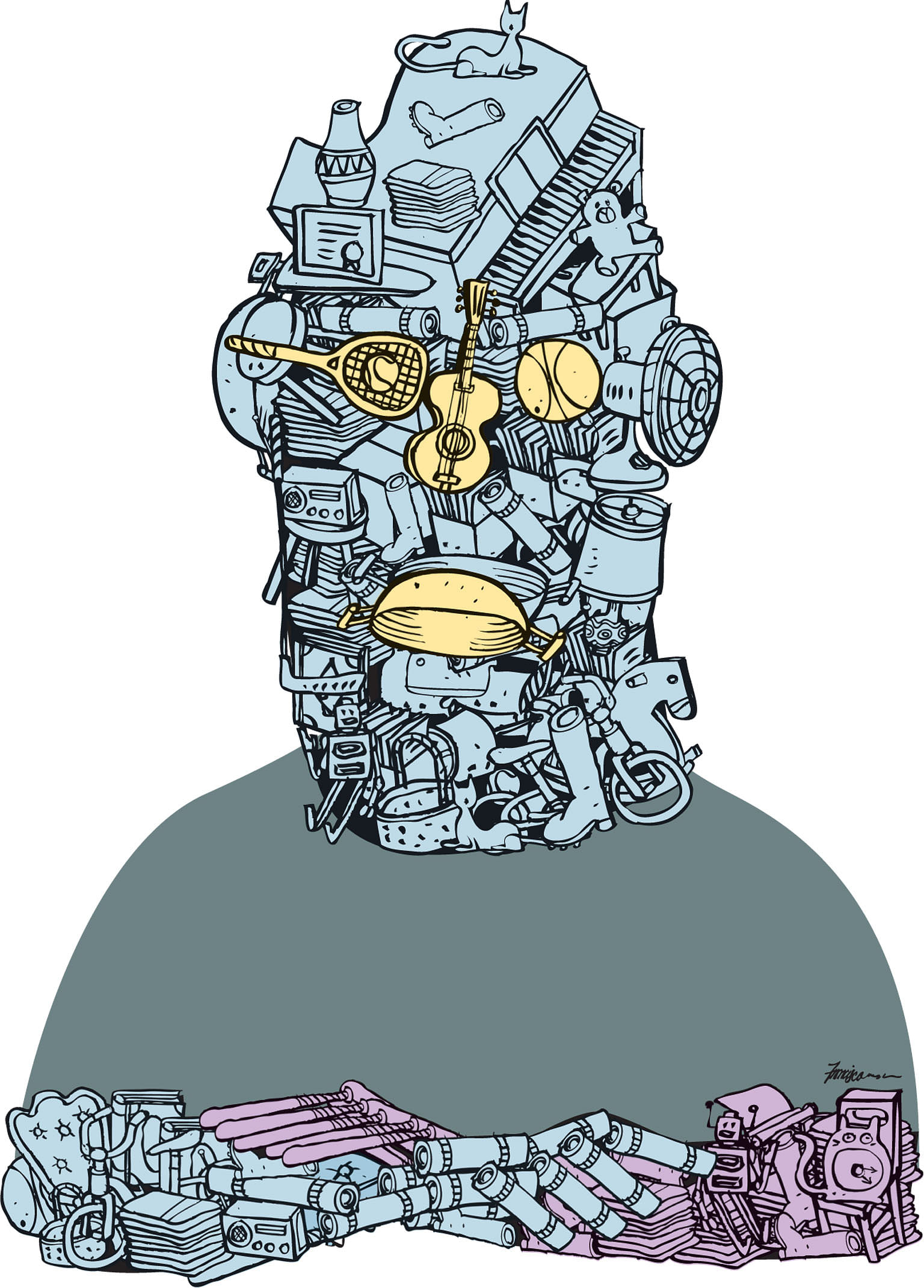Many Americans would know about the Collyer brothers whose fatally intertwined lives have been a cautionary tale for children who don't clean up their rooms and adults who let themselves slide into an undisciplined and unbridled accumulation of possessions.
Homer and Langley Collyer were the scions of a distinguished family (their father was a respected if eccentric gynaecologist who canoed to work from Harlem to Bellevue Hospital). The two brothers lived in a four-storey brownstone in Manhattan, in the first half of the 20th century. Homer had a law degree from Columbia University and Langley studied engineering. Both worked for a while, and quite inexplicably stopped working one day and withdrew into their mansion. The massive house fell into disrepair: broken windows were not replaced, the front stoop with its balustrades collapsed, and rubbish piled high in the basement entrance. Rumours of money stashed in the decaying mansion led to numerous break-ins.
Homer eventually went blind and became an invalid who was totally dependent on his brother, Langley, who rarely went out except late at night to get food.
In 1947, a call was made to the police to report that someone in the Collyer mansion might have died. When the police tried to enter through the main entrance, they were blocked by a mountain of junk that seemed to have spilled from the bowels of the mansion, but they managed to clamber through a second-storey window. After a day's search, they found the body of Homer: keeled over with his head on his knees. It was another 18 days before they found the corpse of Langley, about 3m away from where his brother had lain.
The house contained what, in the end, was said to have been more than 170 tonnes of amassed items: toys, bicycles, guns, chandeliers, tapestries, mantel clocks, violins, a cello, thousands of books, bales of newspapers, 14 grand pianos, an organ, the chassis of a Model T Ford, a horse's jawbone, and Dr Collyer's canoe. Running through the jam-packed rooms was a labyrinth of tunnels rigged with booby traps to foil burglars. Langley was apparently bringing food to Homer when he was snared by one of his booby traps which buried him under piles of debris. And Homer subsequently starved to death.
The Collyer brothers and their stupendous hoarding have since become the perennial classic case study in the annals of compulsive hoarding. The scholarly and scientific work in the last two decades has been pivotal in establishing hoarding as a disorder in the American Psychiatric Association's latest edition of its Diagnostic And Statistical Manual Of Mental Disorders (the predominant reference book that enumerates the features of most known mental disorders); where the key feature is a persistent acquiring of, coupled with a difficulty in discarding, possessions, regardless of their actual value, and to the extent where they clutter and congest living areas and impede their intended use, causing impairment of functioning.
HAPLESS VICTIMS
The research has given us some understanding of the subterranean mental processes driving this behaviour. Hoarders have a paralysing indecisiveness when it comes to discarding things - they are convinced of their future usefulness or value so they avoid making (or postpone perpetually) any decision about their disposal.
They are unable to categorise and organise their possessions which they heap haphazardly in a proliferating number of piles (a process referred to as churning); and by mixing important and valuable things with worthless items, they inadvertently exacerbate their terror of losing valuable possessions and so will not risk throwing out anything.
Some evidence has linked the onset of hoarding to traumatic life events such as assault, injury, the breakup of a close relationship which makes certain individuals feel particularly vulnerable in what they perceive to be a volatile, capricious world; so they fall back on their physical possessions which they see as firm and immutable for a sense of security.
Some see their possessions not only as extensions of themselves but may even anthropomorphise these objects - animating them with human-like properties, and forming such a bond with them that they would agonise over wanting to ensure (and assure themselves) that their discarded possession remains unharmed or goes to a good home, or not at all.
Despite these psychological insights, there are no generally effective treatments, though psychological treatment like cognitive behavioural therapy that tries to curb the urge to acquire and to loosen the attachment to these things is successful in some cases.
Hoarders, however, are extremely difficult to engage. Their denial of the anomalous excessiveness, the apparent callous disregard of the health and safety of others, and the recalcitrant resistance to any professional help, can be baffling and frustrating. But they are more hapless victims of an irresistible and consuming urge to acquire and accumulate items than wilful prevaricators. Their strange logic and profound fears of losing their possessions take the wind out of any motivation for treatment, and blind them to the potential harm that they place themselves and others in.
And when the hoarding poses a risk of harm, this is when and where the rights (and interests) of the individual to do whatever he wants with his own things in his own home, and the rights of others to be safe from harm, come up against each other.
SISYPHEAN STRUGGLE
To deal with the complex problems that severe hoarding in the community can cause, a Hoarding Taskforce was set up in Singapore in 2014. Involving the Ministry of National Development, Ministry of Health, Ministry of Social and Family Development (MSF), the police, Housing and Development Board (HDB), Singapore Civil Defence Force (SCDF), National Environment Agency, People's Association, and Institute of Mental Health, members of this task force have their work cut out for them.
A man's home is still very much his castle here, and there are no laws specifically made to deal with hoarding.
Even in a case of hoarding in an HDB flat, the owner's consent has to be given before officers of the HDB or town councils can enter the premises, let alone intervene in any way. (The powers of intervention are even more limited where hoarding occurs within a private property.)
Hoarding within one's residence is generally not a criminal offence so the police can't act, though the Mental Health (Care and Treatment) Act has a provision for the police "to apprehend any person who is reported to be mentally disordered" but only if that person "is believed to be dangerous to himself or other persons by reason of mental disorder" which is a rather high bar.
The SCDF can only intervene if the hoarding situation results in fire hazards and/or emergencies.
The Vulnerable Adult Act applies only in cases where the hoarding can harm or has harmed a vulnerable adult - defined as a person who is 18 years of age or older; and is, by reason of mental or physical infirmity, disability or incapacity, incapable of protecting himself or herself from abuse, neglect or self-neglect - in which case, MSF could apply for a court order for the home to be made safe, on behalf of that vulnerable adult.
So, unless there is a clear and present danger or a criminal offence, the assortment of available laws which can be appropriated can't quite do the job of resolving a case of hoarding - no matter how troubling it might be to others. Experience elsewhere has shown that taking an adversarial and heavy-handed approach is counter-productive and doesn't work in the long run, so a mediatory approach is preferred - at least, in theory.
A hoarder I know told me that HDB officers would visit his flat on a regular basis. He suspects some of his neighbours had complained to HDB or the town council because his "things" had overflowed from his one-room flat onto the common corridor. He has no rancour towards these neighbours (some of them gave him things they did not want when they moved elsewhere).
Afraid that he might be evicted, he acquiesces reluctantly to the demands that he declutter. Powerless to do it himself, he submits to having it done for him. Unable to bear seeing his treasured possessions bagged and carted away like rubbish, he leaves the decluttering crew to their task, goes to a landing on one of the stairways, leans out and screams a couple times to vent his pent-up anguish. After dawdling a while, he then returns to his emptied-out flat and before long, he starts bringing home more items. And before long, the HDB officers and their decluttering crew turn up again. This Sisyphean struggle continues to this day - but at least, the neighbours are appeased.
- The writer is vice-chairman of the medical board (research) at the Institute of Mental Health.



